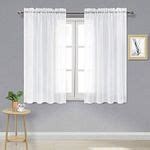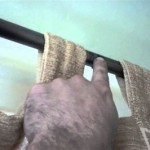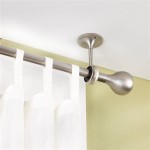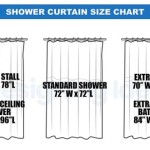How Much Curtain Should Touch the Floor? A Comprehensive Guide
The question of how much curtain should touch the floor is a crucial element in interior design, impacting both the aesthetic appeal and functionality of a space. There is no universally correct answer, as the ideal length depends on various factors including personal preference, the style of the room, the type of fabric, and the intended purpose of the curtains. This article provides a detailed exploration of the different curtain lengths and their respective advantages and disadvantages, aiming to equip individuals with the knowledge necessary to make informed decisions about curtain length.
Traditionally, curtains were primarily functional, serving to block light and provide privacy. As interior design evolved, curtains transformed into decorative elements, playing a significant role in defining the style and ambiance of a room. The length of the curtain became an integral part of this transformation, offering opportunities to create different visual effects and enhance the overall design scheme.
The decision about curtain length involves considering various factors. A crucial element is the architectural style of the room. Modern homes often benefit from a more streamlined and minimalist aesthetic, while traditional homes may suit more elaborate and opulent curtain styles and lengths. The height of the ceiling is also a significant determinant. High ceilings can accommodate longer curtains that create a dramatic effect, while shorter curtains may be more appropriate for rooms with lower ceilings to avoid overwhelming the space.
Finally, the intended function of the curtains should be carefully considered. Curtains designed primarily for light blocking and privacy may require a different length than those intended solely for decorative purposes. Understanding these factors is essential for selecting the appropriate curtain length that complements the room's design and fulfills its intended function.
The Floating Curtain: A Practical and Modern Choice
A "floating" curtain refers to a length that stops approximately half an inch to one inch above the floor. This style is characterized by its clean lines and practical benefits, making it a popular choice for modern homes and high-traffic areas.
One of the primary advantages of floating curtains is their practicality. Since they do not touch the floor, they are less likely to collect dust, dirt, and pet hair. This makes them particularly suitable for individuals with allergies or those seeking a low-maintenance window treatment option. The ease of cleaning is a significant benefit, as these curtains do not require frequent vacuuming or dusting along the hemline.
From a visual perspective, floating curtains create a sense of lightness and airiness in the room. The small gap between the curtain and the floor prevents the curtains from appearing too heavy or overwhelming the space. This is especially beneficial in smaller rooms where maintaining a sense of openness is crucial. The clean lines of floating curtains also contribute to a modern and minimalist aesthetic, complementing contemporary interior design styles.
However, floating curtains may not be suitable for all situations. One potential drawback is that they can sometimes appear slightly too short if the measurements are not precise. Even a small discrepancy in length can disrupt the visual balance of the room. Furthermore, floating curtains may not offer the same level of insulation as longer curtains that touch the floor, as the gap can allow for drafts and heat loss. This is an important consideration for individuals living in colder climates or those seeking to maximize energy efficiency.
The choice of fabric can also influence the overall appearance of floating curtains. Lightweight fabrics such as linen or voile can enhance the sense of airiness and lightness, while heavier fabrics such as velvet or brocade may appear too bulky and out of proportion when used in a floating style. Careful consideration of the fabric is essential to ensure that the curtains complement the room's design and achieve the desired aesthetic effect.
The Kissing Curtain: A Balanced and Versatile Option
A "kissing" curtain is a length that just barely touches the floor, creating a soft and subtle connection between the window treatment and the room's surface. This style offers a balanced combination of aesthetic appeal and practicality, making it a versatile choice for various interior design styles.
One of the key advantages of kissing curtains is their ability to create a polished and tailored look without the added maintenance of longer, pooling curtains. The slight contact with the floor adds a touch of elegance and sophistication, enhancing the overall visual appeal of the room. This style is particularly well-suited for formal living rooms, dining rooms, and bedrooms where a refined and stylish ambiance is desired.
From a functional perspective, kissing curtains provide a moderate level of insulation and light blocking. The slight contact with the floor helps to minimize drafts and prevent light from seeping in around the edges of the curtains. This can contribute to improved energy efficiency and enhanced privacy, making kissing curtains a practical choice for bedrooms or other areas where light control is important.
However, precise measurements are crucial when opting for kissing curtains. The goal is to achieve a subtle and seamless connection with the floor, without any visible gap or excessive pooling. Any discrepancy in length can disrupt the visual balance and detract from the overall aesthetic appeal. Therefore, it is essential to take accurate measurements and work with an experienced seamstress or installer to ensure a perfect fit.
The choice of fabric can also influence the overall appearance of kissing curtains. Medium-weight fabrics such as cotton or linen blends are often ideal, as they provide a good balance of drape and structure. Heavier fabrics may appear too stiff and formal, while lighter fabrics may lack the necessary weight to achieve a smooth and elegant drape.
Maintenance for kissing curtains is relatively straightforward. While they may require occasional vacuuming or dusting along the hemline, they are less prone to collecting dirt and debris compared to longer, pooling curtains. This makes them a practical choice for individuals seeking a stylish yet manageable window treatment option.
The Puddle Curtain: A Dramatic and Luxurious Statement
A "puddle" curtain refers to a length that extends several inches beyond the floor, creating a dramatic and luxurious pooling effect. This style is characterized by its opulent appearance and ability to add a sense of grandeur and sophistication to a room.
One of the primary advantages of puddle curtains is their visual impact. The excess fabric that pools on the floor creates a sense of drama and luxury, transforming the window treatment into a focal point of the room. This style is particularly well-suited for formal living rooms, bedrooms, and other areas where a statement of elegance and opulence is desired.
From a functional perspective, puddle curtains offer excellent insulation and light blocking. The excess fabric helps to minimize drafts and prevent light from seeping in around the edges of the curtains. This can contribute to improved energy efficiency and enhanced privacy, making puddle curtains a practical choice for bedrooms or other areas where light control is important.
However, puddle curtains require careful consideration of the fabric and maintenance. Heavyweight fabrics such as velvet, silk, or brocade are often ideal, as they provide the necessary weight and drape to create a luxurious pooling effect. Lighter fabrics may lack the structure and volume needed to achieve the desired aesthetic.
Maintenance for puddle curtains can be more demanding compared to shorter styles. The excess fabric is prone to collecting dust, dirt, and pet hair, requiring frequent vacuuming or dusting along the hemline. Additionally, the pooling effect can make the curtains more susceptible to damage from spills or stains. Therefore, it is essential to choose a fabric that is durable and easy to clean, or to consider professional cleaning services.
The length of the puddle is also an important consideration. While a longer puddle can create a more dramatic effect, it can also be more prone to collecting dirt and debris. A shorter puddle may be more practical for high-traffic areas or homes with pets. The ideal length depends on personal preference and the specific needs of the room.
Furthermore, puddle curtains may not be suitable for all interior design styles. They are best suited for formal and traditional settings where a sense of opulence and grandeur is desired. In modern or minimalist homes, puddle curtains may appear out of place and disrupt the overall aesthetic. Careful consideration of the room's style and the desired effect is essential before opting for puddle curtains.

How Close To The Floor Should Your Drapes Hang Ask Expert Style Boston Com Real Estate

Should Curtains Touch The Floor Expert Tips Shade

Should Curtains Touch The Floor Expert Tips Shade

Should Curtains Touch The Floor Expert Tips Shade

Should Curtains Touch The Floor Expert Tips Shade

Should Curtains Touch The Floor Expert Tips Shade

Should Curtains Touch The Floor Guide To Curtain Length

Curtain Length Dilemma To Touch Or Not The Ground F J Outdoors

When Should Curtains Touch The Floor Quickfit Blinds And

Should Curtains Touch The Floor Complete Length Guide 2025








